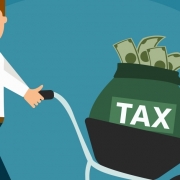Who bears the burden of government indebtedness? Prior to the Keynesian revolution in the mid-20th century, most economists understood that the burden of government (or “public”) debt falls on those citizens who, in the future, must repay the debt. The funds for such repayment can come in the future from higher taxes, from reduced government expenditures on programs other than debt servicing, or from some combination of the two.
But Keynesianism destroyed this consensus. According to what my late Nobel-laureate colleague James Buchanan called the “new orthodoxy” about government debt, all such debt that is owed to fellow citizens – that is, debt that “we owe to ourselves” – is no burden at all upon the generations who must service and repay it.
Three Prongs of the Keynesian Orthodoxy
There are three prongs to this Keynesian orthodoxy. The first prong is rooted in the Keynesian insistence that the main driver of economic activity is the volume of total spending, or what economists call “aggregate demand.” And so if American citizen Smith is taxed an extra $1,000 in order to retire a $1,000 U.S. government bond held by American citizen Jones, there’s no reason to believe that total spending in the American economy will change. While Smith’s spending will fall because his after-tax income falls by $1,000, Jones’s spending will rise upon his receipt of this $1,000. Retiring the debt, therefore, has no effect on economic activity as a whole.
(Because people in, say, France who hold bonds issued by the U.S. government redeem those bonds for U.S. dollars – and because those dollars will eventually be spent in the United States – the commonplace qualification that government debt is no burden “if we owe it to ourselves” is actually unnecessary. This detail, however, need not detain us.)
The second prong of the Keynesian orthodoxy is that the burden on society of government debt is shouldered at each of the moments when programs that are funded with debt are undertaken. If, say, Uncle Sam borrows $10 billion to build 100 F-35 fighter jets today, all of the labor, metals, plastics, and other real resources that would otherwise have been used differently are consumed today to produce the fleet of fighter planes. The 100 commercial jet liners – or the 500,000 automobiles, or the 10,000,000 sets of patio furniture, or some quantity of whatever – that would otherwise have been built are not built. Society today gets 100 F-35s in exchange for giving up whatever else would have been, but was not, built and consumed.
The third prong is that government deficit financing imposes no burden – none! – at any time at all, on anyone at all, when it is done during periods of unemployment. According to Keynesians, if Uncle Sam borrows $10 billion to build a fleet of F-35 fighter planes (or whatever) during a recession, nothing is sacrificed. Keynesians assume that all of the labor and other resources used to build the planes would otherwise have remained in involuntary idleness. And so by pulling those resources out of their unwelcomed idleness, the debt-financed production of the F-35s actually cost nothing at all!
Keynesians believe that during recessions lunches really are free.
This last prong of the Keynesian treatment of government deficit-financing is the most well-known and controversial of the three. It’s also the most far-fetched. If correct, one of the keystones of economics – namely, the ubiquity and inescapability of scarcity – is cast aside and, along with it, the wisdom of heeding lessons taught by economists from Adam Smith in the 18th century through Vernon Smith in the 21st. Yet although incorrect, I hereby ignore this third prong by assuming that the economy is at full employment.
Debt Financing by Government Imposes Burdens on Future Generations
Even at full employment, however, the claim that deficit financing today imposes no burden on future generations is mistaken. Explaining this incorrectness was among the earliest of Jim Buchanan’s many theoretical breakthroughs.
It’s true, of course, that when government borrows money to build fighter jets today it diverts resources away from the production of other goods and services. But – and here’s Buchanan’s key insight – the creditors who today lend money to the government do so voluntarily. As Buchanan explained in his 1958 book, Public Principles of Public Debt, each of these creditors expects to be made better off – in the form of repayment in the future of principal and interest – by his or her purchase of government bonds.
And so while these creditors do indeed reduce their ability to consume goods and services today, their expectation of higher future consumption makes this sacrifice, for them, worthwhile. These creditors, as such, thus are clearly not the people who pay for the fighter jets. These creditors do not bear the burden of supplying government with these new military weapons.
So who does bear the burden of this debt? Buchanan’s correct answer is this: the taxpayers who repay the debt. These taxpayers, in order to transfer resources to the creditors, are compelled to reduce their consumption when payments on government bonds come due. If the bonds all come due one year after they are issued, the burden of financing this debt falls on taxpayers one year later. If instead no payments of interest or principal are due on the bonds until 30 years after they are issued, then the burden of this debt falls on taxpayers starting 30 years hence.
Buchanan noted that future-generations’ bearing of the burden of government debt does not necessarily mean that debt financing was a bad deal for these taxpayers. It’s possible for the government to spend its borrowed funds in ways that taxpayers in the future find to be worth the higher tax bill. If the borrowed funds are indeed spent in this prudent manner, then the debt financing is economically justified.
But Buchanan also showed that this possibility is not a probability. The reason was nicely summarized by the Royal Swedish Academy of Sciences in its announcement of Buchanan’s Nobel Prize: “He showed how debt financing dissolves the relation between expenditures and taxes in the decision-making process.”
In effect, debt financing allows government to spend money today while foisting the tab on future taxpayers – many of whom, literally, aren’t yet born. Politicians eager to win votes are thus prone to borrow and spend excessively because borrowing allows the current generation to free-ride on the incomes of future generations.
Unfortunately, too few people bother to think carefully through the economics of government taxing, spending, and borrowing decisions, yet everyone can easily see the programs funded with today’s expenditures.
Today’s looming fiscal mess is the predictable consequence of politicians’ ability to spend today and to stick our children and grandchildren with the bill.
Donald J. Boudreaux is a senior fellow with American Institute for Economic Research and with the F.A. Hayek Program for Advanced Study in Philosophy, Politics, and Economics at the Mercatus Center at George Mason University













